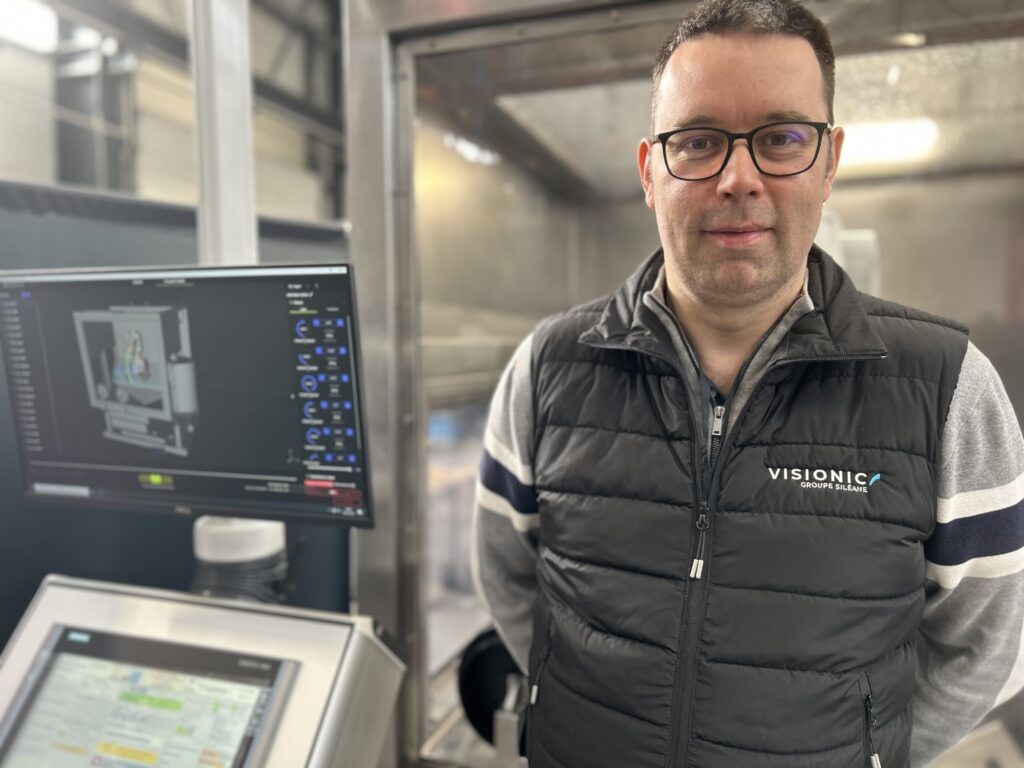Visionic designs off-the-shelf optical guidance and control solutions for complex industrial manufacturing processes. For its part, Fuzzy Logic aims to democratize industrial robotics with its no-code Fuzzy Studio software, which allows non-experts to create, simulate and control a robotic cell in real time.
Together, these partners are removing technological and financial obstacles to the robotization of applications that were previously unheard, in particular the pressure cleaning and decontamination of engine parts in the aeronautics industry, currently carried out manually, exposing operators to the risk of RSI.
The complexity of robotization in this type of application, due to the diversity and number of parts, as well as the cost and availability of roboticists, makes automation challenging. To solve these problems, Visionic has developed an innovative robotic cell that includes a chassis, robot, high-pressure hydraulic circuits, filtration system and particle recovery system, controlled by Fuzzy Studio. This solution, which is unique on the market, makes it possible to automate these complex tasks without any expertise in robotic programming.
Testimonial from Baptiste Laroche – Robotic Automation Manager at Visionic

Can you please introduce yourself?
I’ve been with Visionic for almost 20 years. I started in 2004 with a 3-year apprenticeship at an engineering school in Saint-Étienne-Du-Rouvray, and at the end of that period, in 2007, Visionic hired me. So I know the history of Visionic very well. I’ve worked first as an automation and robotics technician, then as head of the automation and robotics department, where I trained two other apprentices myself. We started our partnership with Fuzzy Logic during Covid.
Today we’re implementing the Fuzzy Production package (Fuzzy Studio + Fuzzy RTOS) on a machine for an aircraft manufacturer, although the software had already been used for another application with Framatome [for a non-destructive testing application]. We had integrated a Vaxx sensor that can be used to profile parts.
Why choose our software, Fuzzy Studio?
The Fuzzy Studio tool allows the customer to take full control and directly create a robot trajectory without any specific robotics training. Otherwise, we would have needed basic training to use ABB [the robot used in the cell], their RobotStudio offline programming tool, which remains a specific tool with a more restrictive business approach than Fuzzy Studio.
Their software is much more accessible and intuitive, even for non-experts. Our customer worked with a trainee who learned the software on his own with the help of your videos and tutorials. Even though he worked with people trained by Fuzzy Logic in Paris, who were able to support and guide him in the beginning, he then managed on his own. He was the one who created the trajectories for the parts that we validated on the machine before delivering them to the customer.
What might have prevented you from using and/or buying our solution?
It depends on the type of application and the customer’s needs, because that’s what motivates them to use Fuzzy Studio. There aren’t really any obstacles, but rather needs to be defined in order to use your software.
The benefit for our customer was that it gave him a tool to create trajectories and add new ones on his own, without having any specific robotics knowledge. That’s the strength of the software. And even if we use a different machine with a different robot, the software stays customized. You can still use the application with a different robot, which I think is another big advantage. As well as the flexibility of the robots and the generation of trajectories for “non-initiates” in robotics, in quotes, because you still need to be competent in the 3D part.
What would be the most useful feature for you?
Obviously, the ease of offline programming. This is one of the two great advantages of Fuzzy Logic, along with its multi-brand universality.
What have been the main benefits of the software since you installed it?
Generating trajectories for non-experts, according to the customer’s needs. This is made concrete by the fact that they can create the trajectories themselves. This is exactly the functionality we purchased.
Why would you recommend it?
It’s a fascinating tool for applications with complex trajectories where you need to let the customer take control autonomously or add new diversities.
For which applications or business sectors are fuzzy solutions essential?
Not necessarily those with high production rates, but rather those with small production runs, such as in the aerospace industry, and also depending on the complexity of the process.
